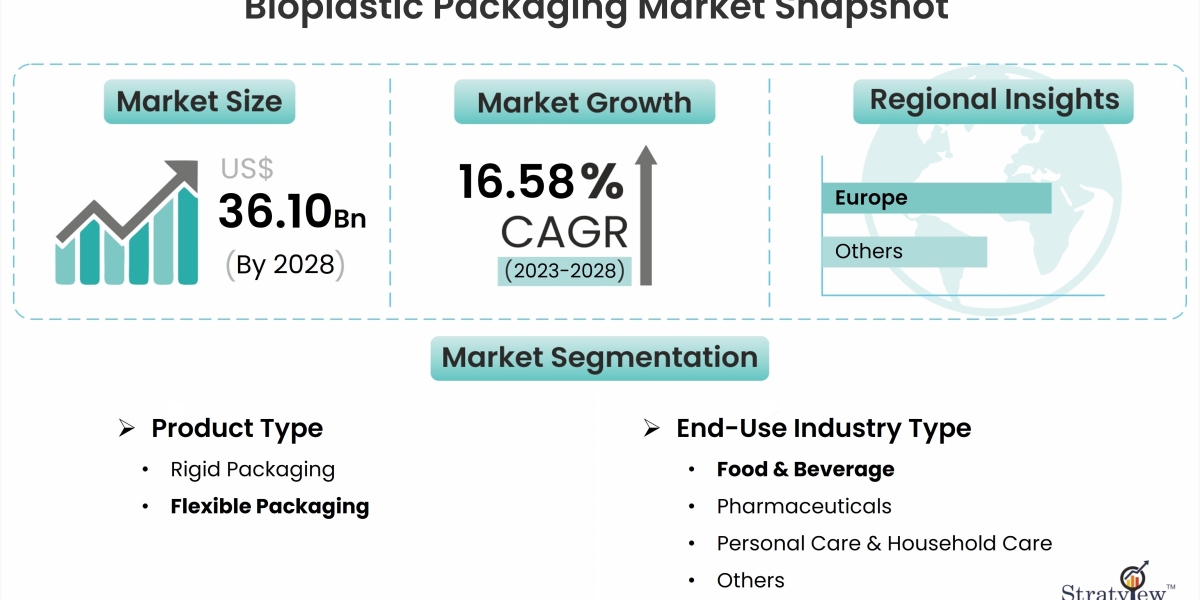Introduction
As the world grapples with the consequences of plastic pollution, the emergence of bioplastic packaging offers a glimmer of hope for a more sustainable future. While bioplastics hold promise, it's essential to conduct a thorough analysis of their environmental impact to understand their true potential in mitigating the plastic crisis. This article provides a comprehensive examination of the environmental implications of bioplastic packaging, delving into its production, disposal, and overall footprint.
According to Stratview Research, The Global Bioplastic Packaging Market is expected to grow from USD 14.38 billion in 2022 to USD 36.10 Billion by 2028 at a healthy CAGR of 16.58% during the forecast period of 2023-2028 .
Biodegradable plastics that are made up of biological substances without petroleum are termed bioplastics. They are generally produced with microorganisms, renewable raw materials, petrochemicals, or combinations of all three.
To learn more about the report, click here:
https://www.stratviewresearch.com/1178/bioplastic-packaging-market.html
The Production Process: A Greener Alternative?
Bioplastic packaging starts its journey from renewable resources like corn, sugarcane, or other organic materials. The production process, compared to traditional plastic, generally emits fewer greenhouse gases and reduces reliance on finite fossil fuels. However, it's crucial to consider the entire life cycle, including cultivation, transportation, and processing, to accurately gauge the environmental benefits.
Reducing Carbon Footprint: Fact or Fiction?
One of the key selling points of bioplastic packaging is its potential to lower the carbon footprint. The cultivation and processing of organic feedstocks can be more energy-intensive than extracting petroleum from traditional plastics. Therefore, careful consideration must be given to the energy sources used in bioplastic production, as well as transportation and manufacturing, to ensure a net reduction in emissions.
Biodegradability vs. Compostability: Navigating Disposal Methods
Bioplastics are designed to break down naturally, but it's essential to distinguish between biodegradability and compostability. Biodegradable plastics can degrade in various environments, but this process can still release harmful residues. Compostable plastics, on the other hand, break down into organic matter, providing valuable nutrients to the soil. Proper disposal methods are crucial to realize the full environmental benefits of bioplastic packaging.
Land Use and Agricultural Impact
The cultivation of feedstocks for bioplastic production can have implications for land use and agriculture. Large-scale monoculture farming, if not managed sustainably, can lead to soil degradation, biodiversity loss, and competition with food crops. Responsible farming practices and land management must be employed to ensure the sustainability of bioplastic feedstock production.
End-of-Life Considerations
The end-of-life stage is a critical factor in assessing the environmental impact of bioplastic packaging. If streams are disposed of in regular waste, bioplastics can end up in landfills, where they may not have the conditions required for effective degradation. Proper infrastructure and education are essential to ensure that bioplastics are channeled into composting facilities, where they can return valuable nutrients to the soil.
The Role of Regulations and Certification
Effective regulation and certification standards play a pivotal role in ensuring the environmental integrity of bioplastic packaging. Industry-wide standards can help differentiate truly sustainable bioplastics from those that may not deliver the promised benefits. This oversight is crucial in maintaining consumer trust and promoting responsible practices within the bioplastics industry.
Balancing the Scale: Challenges and Opportunities
While bioplastic packaging holds immense potential, it is not without its challenges. Scaling up production to meet global demand, ensuring consistent quality, and addressing cost considerations are areas that require ongoing innovation and investment. Collaboration between industry, leaning, and environmental advocates will be crucial in overcoming these hurdles.
Conclusion: A Step Towards a Sustainable Future
The environmental impact of bioplastic packaging is a multifaceted issue that requires careful consideration of the entire life cycle. When produced responsibly and managed effectively throughout its journey, bioplastic packaging offers a promising alternative to conventional plastics. As technology advances and sustainable practices become more prevalent, bioplastics have the potential to play a significant role in reducing the environmental footprint of packaging materials, contributing to a cleaner, healthier planet for generations to come.
About Us
Stratview Research is a global market research firm, offering syndicated and custom research reports along with growth consulting services. Our business intelligence and industry research reports offer clients insightful market data to aid strategic decision-making. These exclusive reports are the result of exclusive research methodology and are available for key industries such as chemicals, composites, advanced materials, technology, renewable energy, and more.
Stratview Research delivers custom research services across sectors. In case of any custom research requirements, please send your inquiry to sales@stratviewresearch.com or connect with our experts at +1-313-307-4176.









